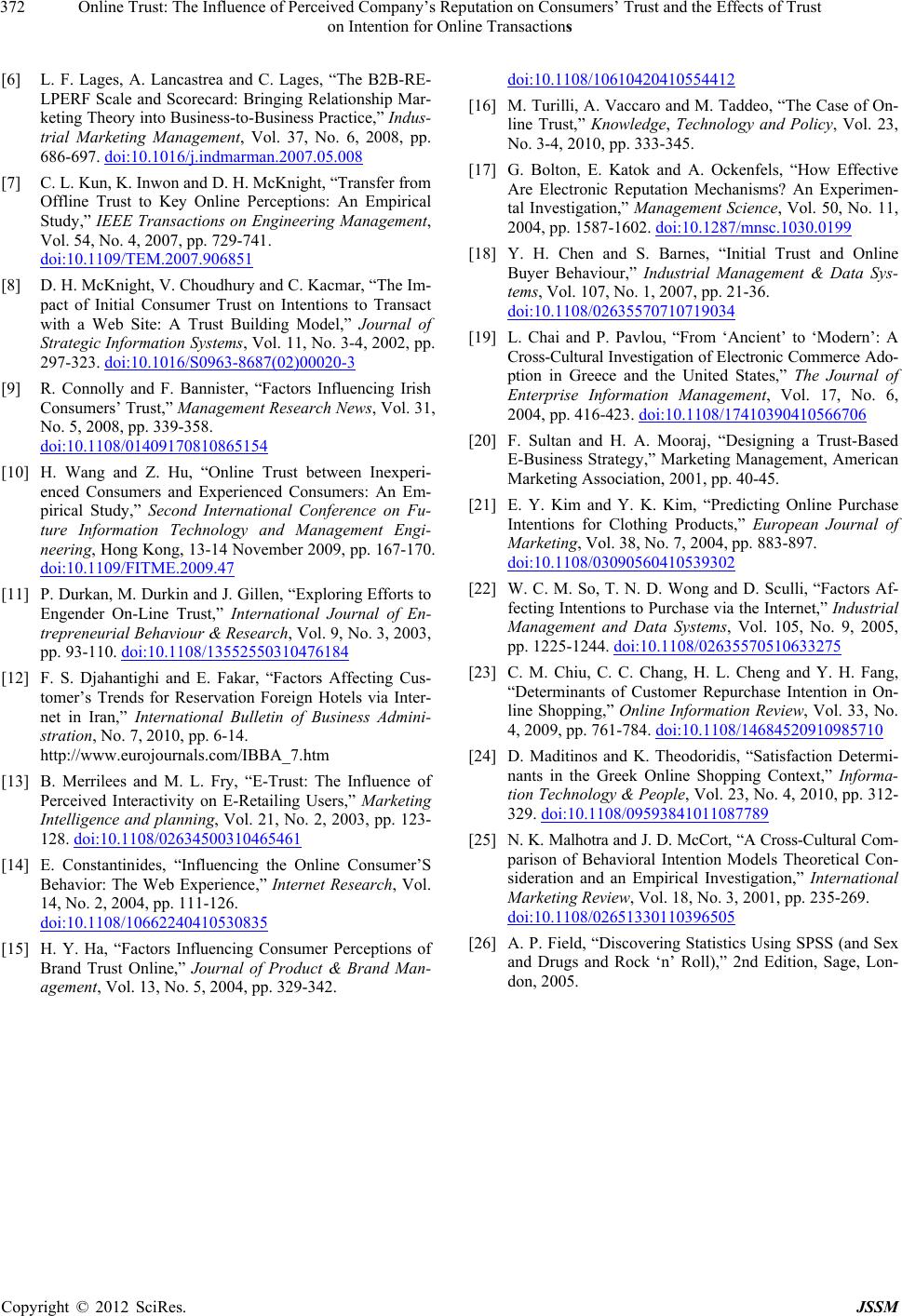
Online Trust: The Influence of Perceived Company’s Reputation on Consumers’ Trust and the Effects of Trust
on Intention for Online Transactions
372
[6] L. F. Lages, A. Lancastrea and C. Lages, “The B2B-RE-
LPERF Scale and Scorecard: Bringing Relationship Mar-
keting Theory into Business-to-Business Practice,” Indus-
trial Marketing Management, Vol. 37, No. 6, 2008, pp.
686-697. doi:10.1016/j.indmarman.2007.05.008
[7] C. L. Kun, K. Inwon and D. H. McKnight, “Transfer from
Offline Trust to Key Online Perceptions: An Empirical
Study,” IEEE Transactions on Engineering Management,
Vol. 54, No. 4, 2007, pp. 729-741.
doi:10.1109/TEM.2007.906851
[8] D. H. McKnight, V. Choudhury and C. Kacmar, “The Im-
pact of Initial Consumer Trust on Intentions to Transact
with a Web Site: A Trust Building Model,” Journal of
Strategic Information Systems, Vol. 11, No. 3-4, 2002, pp.
297-323. doi:10.1016/S0963-8687(02)00020-3
[9] R. Connolly and F. Bannister, “Factors Influencing Irish
Consumers’ Trust,” Management Research News, Vol. 31,
No. 5, 2008, pp. 339-358.
doi:10.1108/01409170810865154
[10] H. Wang and Z. Hu, “Online Trust between Inexperi-
enced Consumers and Experienced Consumers: An Em-
pirical Study,” Second International Conference on Fu-
ture Information Technology and Management Engi-
neering, Hong Kong, 13-14 November 2009, pp. 167-170.
doi:10.1109/FITME.2009.47
[11] P. Durkan, M. Durkin and J. Gillen, “Exploring Efforts to
Engender On-Line Trust,” International Journal of En-
trepreneurial Behaviour & Research, Vol. 9, No. 3, 2003,
pp. 93-110. doi:10.1108/13552550310476184
[12] F. S. Djahantighi and E. Fakar, “Factors Affecting Cus-
tomer’s Trends for Reservation Foreign Hotels via Inter-
net in Iran,” International Bulletin of Business Admini-
stration, No. 7, 2010, pp. 6-14.
http://www.eurojournals.com/IBBA_7.htm
[13] B. Merrilees and M. L. Fry, “E-Trust: The Influence of
Perceived Interactivity on E-Retailing Users,” Marketing
Intelligence and planning, Vol. 21, No. 2, 2003, pp. 123-
128. doi:10.1108/02634500310465461
[14] E. Constantinides, “Influencing the Online Consumer’S
Behavior: The Web Experience,” Internet Research, Vol.
14, No. 2, 2004, pp. 111-126.
doi:10.1108/10662240410530835
[15] H. Y. Ha, “Factors Influencing Consumer Perceptions of
Brand Trust Online,” Journal of Product & Brand Man-
agement, Vol. 13, No. 5, 2004, pp. 329-342.
doi:10.1108/10610420410554412
[16] M. Turilli, A. Vaccaro and M. Taddeo, “The Case of On-
line Trust,” Knowledge, Technology and Policy, Vol. 23,
No. 3-4, 2010, pp. 333-345.
[17] G. Bolton, E. Katok and A. Ockenfels, “How Effective
Are Electronic Reputation Mechanisms? An Experimen-
tal Investigation,” Management Science, Vol. 50, No. 11,
2004, pp. 1587-1602. doi:10.1287/mnsc.1030.0199
[18] Y. H. Chen and S. Barnes, “Initial Trust and Online
Buyer Behaviour,” Industrial Management & Data Sys-
tems, Vol. 107, No. 1, 2007, pp. 21-36.
doi:10.1108/02635570710719034
[19] L. Chai and P. Pavlou, “From ‘Ancient’ to ‘Modern’: A
Cross-Cultural Investigation of Electronic Commerce Ado-
ption in Greece and the United States,” The Journal of
Enterprise Information Management, Vol. 17, No. 6,
2004, pp. 416-423. doi:10.1108/17410390410566706
[20] F. Sultan and H. A. Mooraj, “Designing a Trust-Based
E-Business Strategy,” Marketing Management, American
Marketing Association, 2001, pp. 40-45.
[21] E. Y. Kim and Y. K. Kim, “Predicting Online Purchase
Intentions for Clothing Products,” European Journal of
Marketing, Vol. 38, No. 7, 2004, pp. 883-897.
doi:10.1108/03090560410539302
[22] W. C. M. So, T. N. D. Wong and D. Sculli, “Factors Af-
fecting Intentions to Purchase via the Internet,” Industrial
Management and Data Systems, Vol. 105, No. 9, 2005,
pp. 1225-1244. doi:10.1108/02635570510633275
[23] C. M. Chiu, C. C. Chang, H. L. Cheng and Y. H. Fang,
“Determinants of Customer Repurchase Intention in On-
line Shopping,” Online Information Review, Vol. 33, No.
4, 2009, pp. 761-784. doi:10.1108/14684520910985710
[24] D. Maditinos and K. Theodoridis, “Satisfaction Determi-
nants in the Greek Online Shopping Context,” Informa-
tion Technology & People, Vol. 23, No. 4, 2010, pp. 312-
329. doi:10.1108/09593841011087789
[25] N. K. Malhotra and J. D. McCort, “A Cross-Cultural Com-
parison of Behavioral Intention Models Theoretical Con-
sideration and an Empirical Investigation,” International
Marketing Review, Vol. 18, No. 3, 2001, pp. 235-269.
doi:10.1108/02651330110396505
[26] A. P. Field, “Discovering Statistics Using SPSS (and Sex
and Drugs and Rock ‘n’ Roll),” 2nd Edition, Sage, Lon-
don, 2005.
Copyright © 2012 SciRes. JSSM